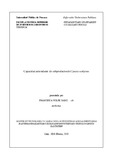Mostrar el registro sencillo del ítem
Capacidad antioxidante de subproductos de Cynara scolymus
| dc.creator | Volpe Sainz, Francesca | es_ES |
| dc.date.accessioned | 2018-08-28T09:03:36Z | |
| dc.date.available | 2023-07-01T23:00:11Z | |
| dc.date.issued | 2018 | |
| dc.identifier.uri | https://hdl.handle.net/2454/30292 | |
| dc.description.abstract | El consumo de vegetales ricos en antioxidantes genera un efecto beneficioso para la salud, ya que reduce el estrés oxidativo de las células. Actualmente existe un elevado número de investigaciones cuyo objetivo es encontrar fuentes de antioxidantes naturales en residuos de la industria agroalimentaria. La alcachofa es un vegetal con un alto contenido en compuestos bioactivos como flavonoides y ácidos hidroxicinámicos. En la industria agroalimentaria, se desecha un 80% de este vegetal, entre brácteas externas, tallos y hojas. Estos subproductos podrían utilizarse como fuente de compuestos bioactivos al presentar un elevado contenido de antioxidantes. Existen numerosos métodos para cuantificar la capacidad antioxidante de un extracto, y los ensayos más usados son los métodos ABTS, DPPH y FRAP. El objetivo del presente trabajo fue determinar la capacidad antioxidante de extractos de alcachofa, obtenidos con diferentes tratamientos de extracción, mediante diferentes métodos analíticos y cuantificar el contenido fenólico total de los extractos. Los valores más elevados de capacidad antioxidante se obtuvieron con el método FRAP, seguido del DPPH y ABTS. Los extractos obtenidos con una mezcla de metanol:agua al 60 %, presentaron mayor capacidad antioxidante que los extractos obtenidos únicamente con agua. Además, la aplicación de ultrasonidos no aumentó la cantidad de extracto obtenida, ni afectó a los compuestos fenólicos presentes en la muestra. Los resultados obtenidos por los tres métodos de capacidad antioxidante presentaron un elevado coeficiente de correlación con el contenido fenólico total. | es_ES |
| dc.description.abstract | Consumption of vegetables rich in antioxidants produces a beneficial effect for health, since it reduces the oxidative stress of the cells. Currently there is a large number of research works with the aim of finding sources of natural antioxidants in the agri-food industry wastes. Artichoke is a vegetable with a high content of bioactive compounds such as flavonoids and hydroxycinnamic acids. In the processing industry, 80% of artichoke is discarded, including external bracts, stems and leaves. These by-products could be used as a source of bioactive compounds since they have a high content of antioxidants. There are several methods to determine the antioxidant capacity of the obtained extracts, and the most used essays are the ABTS, DPPH and FRAP methods. The aim of the present work was to determine the antioxidant capacity of artichoke extracts, which were obtained with different extraction treatments, using different analytical methods and to quantify the total phenolic content of these extracts. The highest values of antioxidant capacity were obtained with the FRAP method, followed by DPPH and ABTS. The extracts obtained with a mixture of methanol:water at 60%, had greater antioxidant capacity than extracts obtained only with water. In addition, the application of ultrasound did not increase the amount of extract obtained and did not affect the phenolic compounds present in the sample. Results obtained by the three methods used to quantify the antioxidant capacity showed a high correlation coefficient with total phenolic content. | es_ES |
| dc.format.mimetype | application/pdf | en |
| dc.language.iso | spa | en |
| dc.subject | Capacidad antioxidante | es_ES |
| dc.subject | Alcachofa | es_ES |
| dc.subject | Subproductos | es_ES |
| dc.subject | Flavonoides | es_ES |
| dc.subject | Ácidos hidroxicinámicos | es_ES |
| dc.subject | Compuestos fenólicos | es_ES |
| dc.subject | Antioxidant capacity | es_ES |
| dc.subject | Artichoke | es_ES |
| dc.subject | By-products | es_ES |
| dc.subject | Flavonoids | es_ES |
| dc.subject | Hydroxycinnamic acids | es_ES |
| dc.subject | Phenolic compounds | es_ES |
| dc.title | Capacidad antioxidante de subproductos de Cynara scolymus | es_ES |
| dc.type | Trabajo Fin de Máster/Master Amaierako Lana | es |
| dc.type | info:eu-repo/semantics/masterThesis | en |
| dc.date.updated | 2018-08-27T10:57:46Z | |
| dc.contributor.affiliation | Escuela Técnica Superior de Ingenieros Agrónomos | es_ES |
| dc.contributor.affiliation | Nekazaritza Ingeniarien Goi Mailako Eskola Teknikoa | eu |
| dc.description.degree | Máster Universitario en Tecnología y Calidad en las Industrias Agroalimentarias por la Universidad Pública de Navarra | es_ES |
| dc.description.degree | Nekazaritzako Elikagaien Industrietako Teknologiako eta Kalitateko Unibertsitate Masterra Nafarroako Unibertsitate Publikoan | eu |
| dc.rights.accessRights | Acceso abierto / Sarbide irekia | es |
| dc.rights.accessRights | info:eu-repo/semantics/openAccess | en |
| dc.embargo.terms | 2023-07-01 | es_ES |
| dc.contributor.advisorTFE | Ancín Azpilicueta, Carmen | es_ES |
| dc.contributor.advisorTFE | Jiménez Moreno, Nerea | es_ES |


